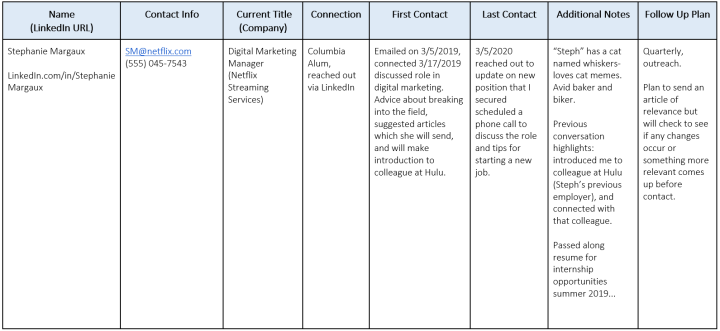Tools to Organize Your Job or Internship Search
The job search or internship search can include many moving parts. It is important to keep yourself organized throughout the process.
HOW TO STAY ORGANIZED IN YouR JOB OR INTERNSHIP SEARCH
We suggest tracking your positions of interest, networking contacts, and interview processes.
- This can be done in Excel, Google Sheets, or a Word/Google document.
- Some use project management tools like Trello or Asana, which offer free memberships.
- You can also combine tools and add alerts and/or reminders to your calendar.
Consider a multi-pronged approach of concurrent networking and applying to optimize your search. You never know where your next role will come from!
HOW TO USE TRACKERS TO OPTIMIzE YOUR SEARCH
Below we will show how to build a tracker and include examples. Feel free to adapt our suggestions to your working style.
Search Tracker
| CATEGORY | DESCRIPTION |
|---|---|
| CATEGORY Target Organization | DESCRIPTION List the organization name. |
| CATEGORY Position Title and URL | DESCRIPTION
List the title of the position and include a link to the posting. Examples: Volunteer, Intern, Fellow, Research Assistant |
| CATEGORY Description | DESCRIPTION
Summarize key elements in the position description. As postings may become inactive, we recommend saving the entire description in a new document. |
| CATEGORY Deadline | DESCRIPTION
If the deadline is unknown or on a rolling basis, it is best to apply sooner rather than later. This can help you prioritize applications and keep your process moving. |
| CATEGORY Source | DESCRIPTION Where you found the opportunity—e.g., referral, networking, LionSHARE, Indeed, etc. |
| CATEGORY Status of Application | DESCRIPTION
Note where you are in the application process—e.g., Submitted, Completed, In Process |
| CATEGORY Networking | DESCRIPTION
Do you have an existing connection to this organization or can you make a new connection? Remember, your network can include classmates, Columbia alumni, professors, advisers, mentors, and/or previous supervisors. You also can reach out to people you don’t know who are linked to the organization. See the Networking tracker below. |
| CATEGORY Research | DESCRIPTION
Research and reflect on your interest to help tailor your application materials and make a positive impression during an interview or a networking conversation. Review the organization’s social media accounts, employee reviews, website, and mission. See if contact information for a recruiter or the human resource team is public through LionSHARE or LinkedIn. |
| CATEGORY Additional Notes and Next Steps | DESCRIPTION
Make note of additional thoughts/ideas that can help you move forward in the search process. You may also want to keep track of the next steps you plan to take. The next step may simply be to finalize the application or follow up with the recruiter. |
Example

Networking Tracker
Networking can be a beneficial part of your job or internship search. In doing so, keep track of the people in your current network as well as those who you’ve reached out to and with whom you’ve connected.
Tap into Columbia’s network through LinkedIn, the Columbia Alumni Association, and events such as industry showcases and career fairs.
Networking can be key to building your professional network for the future even if you are not currently searching for an opportunity.
| Category | Description |
|---|---|
| Category Name of Contact | Description Jot down the name of the contact. |
| Category LinkedIn URL | Description Monitor and note any title/career changes in your tracker. |
| Category Current Title (Organization) | Description Note the person’s current title and employer. |
| Category Contact Information | Description Email address, Twitter handle, phone number |
| Category Connection | Description
Where or how did you get connected? Examples: cold outreach through LinkedIn or the Columbia Alumni Association, an event, introduced by a friend |
| Category First Contact | Description
Include the date and detailed notes from the interaction, which can help you personalize future outreach. |
| Category Last Contact | Description Date and notes from your most recent conversation. Be specific. |
| Category Additional Notes | Description
Keep notes from other interactions that no longer fall into the “first date or last date of contact.” Include shared interests or facts you learn through conversations, as this can help with thoughtful follow up. |
| Category Follow-Up Plan | Description
When do you plan to follow up with this contact? Monthly, quarterly, semi-annually, yearly? What might you follow up on? Follow up might include life or career updates. For instance, maybe your contact has been recently promoted and you’d like to congratulate them. Or, perhaps you’ve just landed a new role and would like to share the news. Other options: sending along relevant articles, wishing them a happy holiday, reaching out about a new project, or reflecting on something you saw in the news about their employer Additionally, you might follow up on actionable steps such as a resource your contact recommended or an introduction that they made on your behalf. |
EXAMPLE

Interviewing Tracker
Interviews are a conversation between you and an employer with the goal of determining fit for a particular role and organization. The employer aims to determine if you have the relevant knowledge, skills, and experience to do the job. They are also looking to see how enthusiastic you are about the role/organization and your motivation to succeed.
Don’t forget, an interview is also your opportunity to learn more about the organization and the people who would be your colleagues there.
It can be helpful to document your preparation, research, and takeaways for each interview experience.
| CATEGORY | DESCRIPTION |
|---|---|
| CATEGORY Organization | DESCRIPTION List the name of the organization. |
| CATEGORY Status | DESCRIPTION
Where are you in the interview process? Examples: scheduled, screening, pre-assessment, second round, final round |
| CATEGORY Position Title/Description | DESCRIPTION
Review the duties, time commitment, and other pertinent details of the role. As postings may become inactive, we recommend saving the entire description in a new document. Summarize key details of the position in your tracker. |
| CATEGORY Format/Structure | DESCRIPTION
What will be the format of the interview? If unknown, can you contact the recruiter to find out? How many interviewers will you be meeting with? What are the steps in the process? If relevant, how are they assessing your technical skills? Format Examples: in-person, phone, virtual, group, panel, technical, case, presentation, superday |
| CATEGORY Company Research | DESCRIPTION
Why are you interested in working at this organization? Conduct research on its mission, product(s)/service(s), clients, competitors, current/upcoming project(s). |
| CATEGORY Preparation | DESCRIPTION
Do you have a clear understanding about the expectations of the position, including time commitment, responsibilities, and qualifications? Practice common interview questions using Big Interview or schedule a practice interview with a career counselor. Make sure you can explain your interest in and relevance for this position and the organization. Identify questions to ask interviewers. |
| CATEGORY Reflection | DESCRIPTION
Think about how the interview went. What questions were asked? How did you feel about the conversation and what you learned about the people, culture, work of the organization? |
| CATEGORY
Thank You Note |
DESCRIPTION
Send a personalized thank you note to everyone you met within 24 hours. Be clear and concise. Reaffirm your interest in the company/role and express gratitude for the opportunity to interview. |
| CATEGORY Follow up | DESCRIPTION
Consider following up by phone or email if you don’t hear back by the date indicated. If no date was given, we recommend reconnecting two weeks after the interview. Be sure to include dates of outreach in your tracker. |
Example
Remember that we are here to support you. Connect with a career counselor at any stage of the process!
